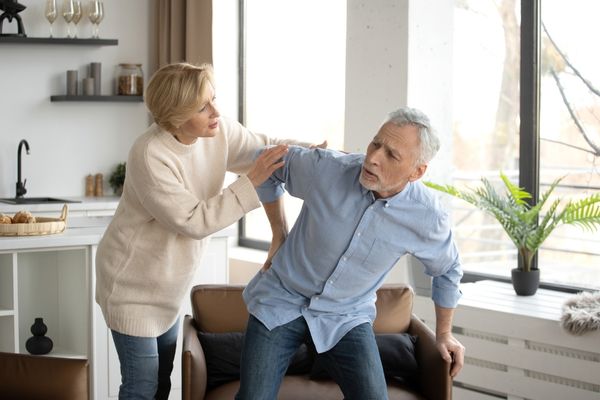
Back pain can affect people of all ages, due to poor posture and sedentary living. Yet as we age, the condition is more likely to become chronic and affect quality of life.
An estimated 80 percent of Americans experience back pain and roughly eight percent develop a chronic case. If you haven’t found long-lasting relief, here’s what you should know.
What Is Chronic Back Pain?
Back pain that lasts for six weeks or longer is considered chronic. You might avoid certain physical activities or adjust your stance to compensate for the discomfort.
In some cases, you might not be able to connect its development with a specific incident. Rather, the pain emerged gradually and has not gone away. Symptoms include ongoing soreness, stiffness, aching or sharp pain in the upper or lower back that possibly radiates down your hips and legs.
While taking an over-the-counter pain reliever, resting or using a topical anesthetic may offer temporary relief, patients are advised to seek medical attention. This becomes particularly urgent if you feel pain or weakness in your lower extremities, experience bladder issues or develop a fever.
Causes of Chronic Back Pain
Although it may develop in response to an injury, chronic back pain typically involves an underlying condition affecting the soft tissue, vertebrae, bones or nerves. Causes often include:
- Muscle Strain: This injury often stems from repetitive lifting or engaging in certain physical activities that can affect the spine, like skiing. Muscle strain can also develop as a result of poor posture, prolonged sitting or body mechanics that place additional force on the spine and adjacent muscles, weakening the core.
- Bulging Disc: Our spinal discs function as shock absorbers. Gradual wear and poor form can push them out of place, causing nerve compression in the process.
- Osteoporosis: The tunnel surrounding the spinal cord becomes constricted, placing pressure on the vertebrae and nerves traveling to other parts of the body.
- Spinal Stenosis: Along with arthritis, bone spurs and disc degeneration can place direct pressure on a nerve, contributing to this condition and chronic back pain.
- Spondylolisthesis: Stemming from poor alignment of the lumbar vertebrae, this condition contributes to disc degeneration and nerve compression.
- Scoliosis: A sideways curve of the spine places more strain on lumbar joints and discs, potentially leading to lower back pain.
- Muscle Atrophy: Also called deconditioning, your muscles can no longer support parts of your body. Often caused by lack of physical activity, this process increases wear and tear on tissues and bones, accelerates through age and increases risks for certain injuries.
- An Accident: Falls and other high-impact injuries can affect the spine, altering your posture and movement, placing greater strain on bones and tissues. These incidents may result in a compression fracture, characterized by sudden pain.
- Overuse Injuries: Repeatedly performing the same movements, especially with poor form, places greater strain on the spine. This can range from sitting in the same position at work to repetitive lifting or sleeping on your side for years.
- Facet Joint Damage: The joints connecting your vertebrae gradually break down due to poor posture or an inflammatory condition like arthritis. With time, decreased cartilage may cause a vertebra to press on a nerve.
Managing Chronic Back Pain
The management of chronic back pain often comes down to changing certain lifestyle habits and guidance from a physical therapist:
- Exercise: Participate in low-impact activities that get your body moving, as well as exercises that help build core strength. Consider walking, bicycling, swimming and strength training that focuses on the back and abdominal region.
- Weight Loss: Carrying around extra pounds can place undue strain on your spine and surrounding muscles.
- Posture: Avoid positions and motions that repeatedly twist your core or place stress on the lower back. While sitting, you may need additional support to help preserve the natural curve of your spine and keep your knees and hips on the same plane.
- Lifestyle Changes: In addition to weight loss, quit smoking – this habit is associated with increased inflammation and back pain.
- Physical Therapy: Sessions may focus on exercises and passive treatments to improve posture, condition and strengthen muscles, as well as engage your core.
Ready to get started? To learn more about how Integrated Rehab addresses chronic back pain, schedule an appointment today.

